 Tourism map
Tourism map
Tour the long-established stores of a shrine town
Serving as a gateway to the sea ever since the kokufu (place of local government) was settled in Tagajo City, the town of Shiogama has prospered as the shrine town of Shiogama Jinja Shrine since the early modern period.
Why not tour some venerable shops that convey history, and get a sense of the passing times in this small shrine town in the Tohoku region?


(includes tour time)
1. Ota Yohachiro syoten

After initially operating a tavern, the founder of this business seized an opportunity and opened a store brewing miso and soy sauce. The traditional flavor that kicked off this store’s history has been passed down, unchanged since 1845, during Japan’s late Edo period.
The Kura Ichiban miso and dashi soy sauce here are highly recommended. The factory was built in 1924 in the Modernist architecture style that was sweeping the world at the time, and a residence attached to the store was built without using nails in 1929. Those buildings received the Shiogama City Cultural Landscape Award.
2. Tanrokuen
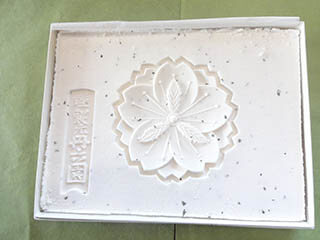
An old shopfront in the town of Shiogama Shrine
As well as selling tea and tea implements, it’s widely known as the manufacturer of Shihogama confectionery.
Established in 1720 during the middle Edo period as a marine wholesale and shipping store, it changed along with the times, becoming a tea vendor, and was never short of customers in the shrine town of Shiogama. The shop served Shihogama as a sweet treat to accompany tea, and records indicate it was also eaten by the fourth daimyo of the Sendai clan, Date Tsunamura.
3. Abekan Syuzoten

Founded in 1716, during the middle Edo period.
For 300 years, this company has continued to brew Japanese sake in Shiogama, and the current president is the 14th-generation proprietor of this historical liquor store. Since it was founded as the Shinto sake brewery for Shiogama Shrine, it still makes offerings of sake at the Shrine at the start of spring.
It principally uses rice produced in Miyagi Prefecture, under the concept “drinks to accompany fish." A great deal is consumed around Miyagi Prefecture and in Shiogama City—and it’s definitely worth taking the opportunity to enjoy it at restaurants in Shiogama.
4. Ogiwara Jozo

Ogiwara Jozo miso and soy sauce brewery with the big barrel placed outside the shopfront.
Although the business was founded in 1887, the house was apparently built in the late Edo period, and 160 years later it has developed into a pleasant, calming space.
The strongest recommendation is the Kiage soy sauce made from undiluted moromi (fermented mash), creating a prized, strong-flavored soy sauce that is completely additive-free. Why not take some time out at the Tama konnyaku store for a quick sample of the flavor?
5. Shiwahiko-Jinja・Shiogama-Jinja
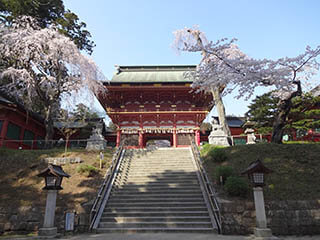
The name of Shiwahiko Jinja Shrine was already evident in the historical Engishiki records, while Shiogama Shrine was known as the main temple and protector of the Oshu region. It is said that the mountain where these two shrines were established, Mount Ichimori, was so named by the first lord of the Sendai clan, Date Masamune, because viewed from Matsushima Bay it looked like the Japanese character ichi (meaning "one").
The shrine buildings, including the main hall and the hall of worship, are designated as Important Cultural Properties. Various plants are also planted here, including the Shiogama Zakura cherry tree, also considered a natural treasure, which entertains visitors with every passing season.
6. Urakasumi Sake-gallery
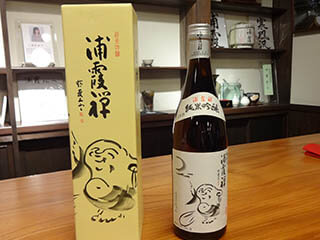
The brewery is famous for the Japanese local sake Urakasumi, which is widely known not only in Miyagi Prefecture, but also all over the world. Founded in 1724, the brewery has continued to brew liquor as the sake brewery for Shiogama Shrine.
Urakasumi received its name in the Taisho period, when it had the honor of presenting sake to the future Emperor Showa. It was named after a poem by Minamoto no Sanetomo, third-generation shogun of the Kamakura Shogunate, who wrote of the misty breeze blowing through the pine trees of Shiogama.
Enjoy fresh seafood
at the wholesale market!
If you visit Shiogama, you should definitely make a stop at the Shiogama Wholesale Seafood Market. It is home to 115 bustling stores offering a varied array of food products including fresh fish, of course, as well as salted preserved foods, frozen foods, dried goods, delicacies, and more. Traders and professionals also come to shop at this market, and visitors can enjoy a "My Seafood Bowl" created by going around and purchasing your own favorite ingredients—one of the true pleasures of the market!!
Enjoy the bounty of the sea to your heart’s content at Shiogama
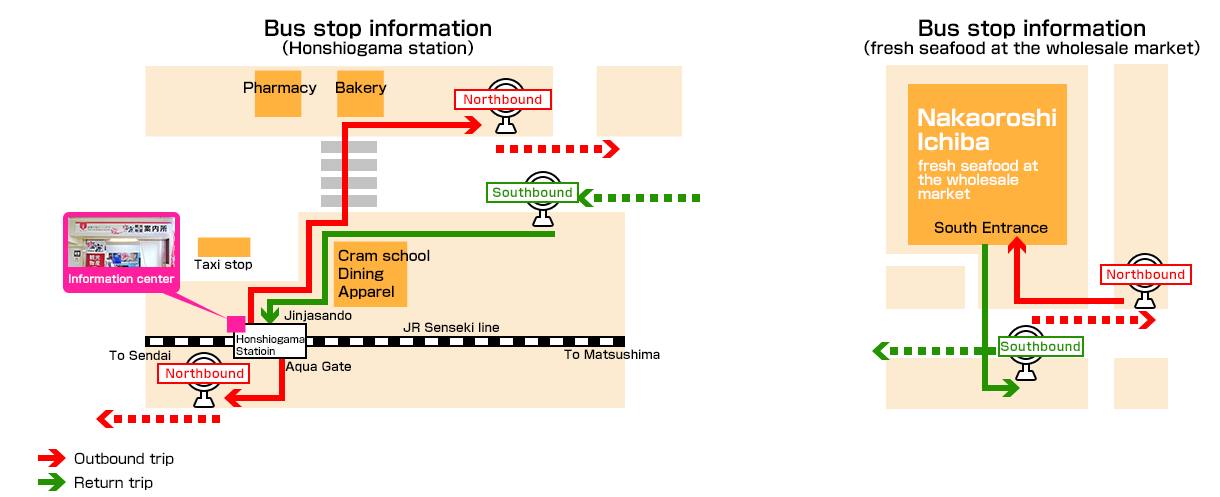

How to make a My Seafood Rice Bowl
1.Go around the market and get your favorite ingredients.
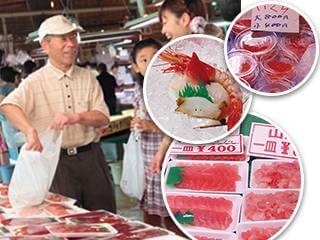
- Look through all the market stores!
・・・There are many unusual ingredients ☆
- Tell the store staff you want to make up a seafood rice bowl!
・・・Ask for their recommendation, or request your seafood “ready to eat.”*Please be aware that assistance may not be possible when crowded.
- Share it among as many people as possible!
・・・Various ingredients are available at reasonable prices.
2.When you’ve collected the ingredients, head to the rest stop to prepare it!!
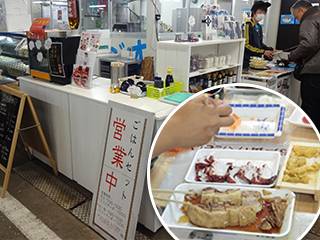
- Buy a rice set for 400 yen!
My Seafood Bowl hours of availability:
Weekdays from 6:30 am to 12:00 noon
Saturdays, Sundays, and holidays from 6:30 am to 1 pm
Closed Wednesdays
*Offer ends as soon as rice is finished.
3.Bam! It's done. Now eat it with pleasure.

Invent completely different seafood rice bowls with various ingredients and methods of preparation.
Enjoy your own seafood rice bowl!
Shiogama as traveled by Basho
Matsuo Basho is regarded as one of the most famous masters of haiku poetry in Japan. Accompanied by his disciple Sora, Basho traveled from Edo Fukagawa to the Tohoku and Hokuriku regions as far as Ogaki in Gifu, as recorded in his famous chronicle Narrow Road to the Interior.
Walk along the paths of Shiogama, following the same route as Basho, and the scenic views of Shiogama that Basho saw will surely extend before your eyes too.


(includes tour time)
The path that Basho took
(He actually walked in Shiogama over 2 days)
June 24, 1689.
June 25, 1689.
1. Okama-Jinja

The undershrine of Shiogama Shrine. This venerates the same kami deity (Shiotsuchi-Oji-no-Kami) as the detached betsugu shrine of Shiogama Shrine.
The place name of Shiogama was derived from the Yonku no Shinkama (the four sacred salt-making vats), when the area was first settled, and legend suggests that the deity Shiotsuchi-Oji-no-Kami taught people how to make salt here.
Also at this shrine, a ritual called moshioyaki shinji is held every July to convey the ancient tradition of salt-making: a rare tradition across the whole country.
Basho left Sendai and arrived at Shiogama around 2 p.m. on June 24, 1689. After having a meal, he stopped by the Okama Jinja Shrine. Stop by and see the Shinkama vats, which Basho apparently also saw! (Admission fee 100 yen)
(300-year monument commemorating Basho’s Narrow Road to the Interior.)
2. Basyo Shisyuku "inn Jihei"
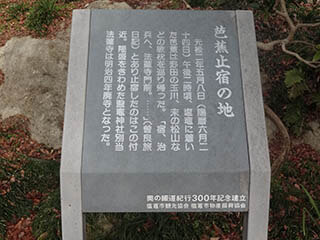
Apparently, Basho and Sora stayed overnight at a place called Jihe, which no longer exists. In this area used to stand Horenji Temple, which was attached to Shiogama Shrine. However, during the Meiji Restoration it fell into ruin, and everything but the Shogaro study room was torn down.
After visiting Okama Shrine, Basho, who also toured Sue-no-Matsuyama and Tamagawa in Noda, reportedly stayed at the Jihe inn near Horenji Temple.
Since the Shogaro study room was close to the inn, it is said that Basho also viewed it.
(300-year monument commemorating Basho’s Narrow Road to the Interior.)
3. Shiogama-Jinja "Bunji-no-Shinto"

It was donated on August 15, 1187, by Tadahira, third son of Fujiwara no Hidehira, third generation lord of the Northern Fujiwara clan. The act of loyalty inspired a lot of people, including Matsuo Basho who praised him in Narrow Road to the Interior, saying, "He is a true and splendid samurai.”
The dedication of the shrine lantern included Tadahira’s oath to protect Lord Yoshitsune by laying down his own life, if necessary, as the descendant of his father Hidehira.
Basho worshiped at Shiogama Shrine on a morning of fine weather on June 25, 1689. At that time, he came across the shrine lantern and was deeply impressed.
(300-year monument commemorating Basho’s Narrow Road to the Interior.)
4. Oku-no-Hosomichi Sekihi
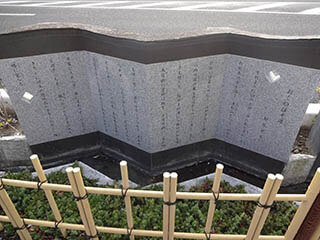
A stone monument stands on the main street of Shiogama Kaido. A partial excerpt from the travel chronicle Narrow Road to the Interior by Basho is inscribed on this stone monument.
5. Basyo Funade spot
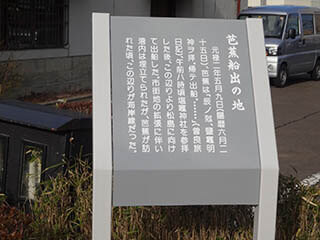
The place where Basho left for Matsushima by sea. In the present day, this is near the long-established Ota Yohachiro store in Shiogama.
This area was once coastline, but due to land reclamation carried out in the 1950s and 60s, Basho’s point of departure by sea is located about 500 meters from the current coastline.
Basho visited Shiogama Shrine on June 25, 1689, then boarded a ship around noon and headed for Matsushima.
(300-year monument commemorating Basho’s Narrow Road to the Interior.)
6. Shiogama port
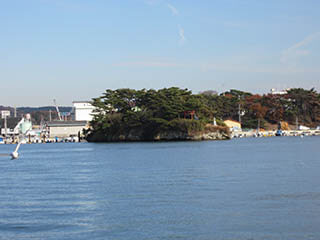
Enjoy views of Shiogama no Ura (Chiga no Ura), which Basho also gazed upon.
Board a pleasure cruise or municipal steam vessel, and you will soon see the island of Magakigashima on the left-hand side.
It is said that Basho was deeply moved by this scenery.
Basho arrived at the pier of Matsushima in Shiogama Bay after close views of the islands of Magakigashima, Dairijima, Miyakojima, Yoroijima, Zaijojima, among others. The distance was recorded as about 2 ri (One Japanese ri is about 4 km).
Magaki-ga-shima
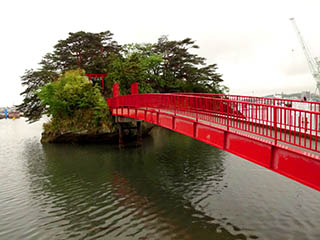
This small island, about 155 meters in circumference, is known as a remarkable place often depicted in Japanese stories and songs.
Magaki Jinja Shrine (Magakishima Myojin), one of the 14 undershrines of Shiogama Shrine, is located here. This moved Basho deeply and passionately when he passed by.
*Please note that the bridge crossing to this island is usually kept locked, and visitors can only cross on the festival day of August 1 every year, as well as the festival dates on the first day of each month.
Exploring the salt roots of Shiogama
Together with over 100 Shinto shrines across Japan, Shiogama Shrine was founded as a shrine to venerate the deities who made the prized salt, rather than to honor politicians or the ruling samurai class.
Why not take a look at another face of this port town, which has maintained its connection to shio (in Japanese, the word shio can mean either “salt” or “tide”) since ages past?


(includes tour time)


But it wasn’t all the ritual of divine salt-making—the actual business of salt production was actively carried out in Shiogama since ancient times.
Shiogama’s moshio salt is made using the ancient salt production method in which carefully refined and boiled sea water is passed through hondawara seaweed. It features a mellow mouthfeel and the distinctive taste of various minerals.
Moshio salt is made over three days, following the ancient method of the moshioyaki shinji ritual, at the Okama Shrine which is an external undershrine of Shiogama Shrine, and the resulting salt is dedicated to Shiogama Shrine.
Shiogama moshio salt is manufactured according to the ancient method of the moshioyaki shinji ritual.
Shiogama moshio salt can be bought at various stores around the city of Shiogama.
Confectionery shops in Shiogama also sell various types of candy made using the salt. It’s fun to stroll around and enjoy candy made with a different flavor—it draws out the sweetness even more!
1. Shiogama-Jinja Betsu-gu
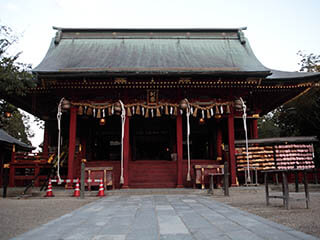
Through the main karamon gate are the right and left halls of the shrine, with the betsugu shrine located to the right of these—a separate hall of worship where the deity Shiotsuchi-Oji-no-Kami is principally enshrined.
Legend suggests that Shiotsuchi-Oji-no-Kami guided the deities Futsunushi-no-Kami and Takemikazuchi-no-Kami (enshrined in the right and left halls, respectively) to this area, and then settled down here, teaching the local people methods of fishing and salt production.
This so-called "god of salt” has been worshiped as a god of safe childbirth by the common folk since ancient times.
2. Shiogama-Jinja museum

There is a focus on the treasures of Shiogama Shrine, including exhibits of offerings made by the powerful Date clan, materials by literary guests who visited Shiogama Shrine, and magnificent handheld mikoshi shrines used at the Hote Matsuri festival and Minato Matsuri Festival.
On the second floor, you can see materials depicting salt-related business with a deep connection to the divine, as well as images reproducing scenes of the ancient moshioyaki shinji salt-making ritual at Shiogama Shrine.
From the rooftop observation deck you can see the view of Matsushima and the Sendai Bay.
*Admission fee: Adults 200 yen
(Separate fee for admission to special exhibitions)
3. Okama-Jinja

This shrine venerates the sacred Shinkama vats, which were used for making salt in ancient time. Shiogama is named after these vats.
It is said that the water inside never overflows or dries up, and that the color of the water changes whenever there is some emergency in the area. For this reason, it is counted as one of Japan’s three strangest phenomena, alongside the Temple of the Stone at Oshiko Jinja Shrine in Hyogo Prefecture and the legendary spear of Amanosakahoko at Kirishima Higashi Jinja Shrine in Miyazaki Prefecture.
The moshioyaki shinji salt-making ritual is held July 4th to 6th every year.
*Okama Shrine admission fee: 100 yen
















